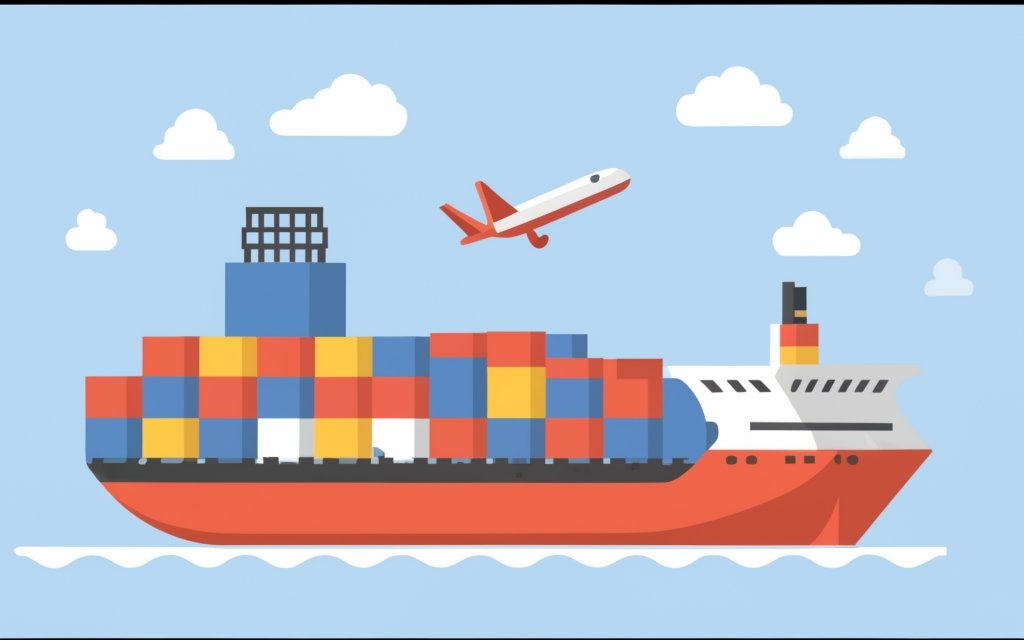CFS shipping, or container freight station shipping, is a type of shipping method that involves consolidating multiple shipments from different shippers into one container. This way, shippers can save on the cost of renting a full container load (FCL) and only pay for the space they use. CFS shipping is especially suitable for small to medium-sized businesses that need to ship goods from China to overseas markets, but do not have enough volume to fill a whole container.
In this article, we will explain everything you need to know about CFS shipping from China, including its advantages, process, documentation requirements, cost factors, and tips for a successful and smooth process. We will also compare CFS shipping with FCL shipping and help you decide which one is right for your business.
Understanding CFS shipping and its advantages

CFS is a type of less than container load (LCL) shipping, which means that the cargo is not shipped in a full container, but rather in a shared container with other shippers’ goods. The process of CFS involves the following steps:
- The shipper delivers the cargo to a designated container freight station (CFS) near the origin port, where the cargo is inspected, packed, and loaded into a container with other compatible shipments.
- The container is then transported to the origin port and loaded onto a vessel for the sea journey.
- Upon arrival at the destination port, the container is unloaded and moved to another CFS, where the cargo is unpacked, sorted, and cleared by customs.
- The shipper or the consignee then arranges for the delivery of the cargo from the CFS to the final destination.
The main advantages of CFS shipping are:
- Cost savings: CFS allows shippers to save on the cost of renting a full container, as they only pay for the space they use. The cost of CFS is usually calculated based on the volume or weight of the cargo, whichever is higher. CFS also reduces the cost of inland transportation, as the cargo is delivered to and picked up from a CFS near the port, rather than from a warehouse or factory far from the port.
- Flexibility: CFS offers more flexibility for shippers who have small or irregular shipments, as they do not need to wait for a full container to be ready. CFS also allows shippers to choose from a variety of destinations and transit times, as there are usually more options for LCL shipping than for FCL shipping.
- Security: CFS provides more security for the cargo, as the cargo is handled and packed by professional staff at the CFS, and sealed in a container with other shipments. The cargo is also less likely to be damaged or lost during the transportation, as it is not exposed to multiple loading and unloading processes.
CFS shipping process and documentation requirements

The process of CFS from China is similar to that of any other international shipping, but with some additional steps and documents involved. Here is a general overview of the process and the documents required:
- The shipper contacts a freight forwarder or a CFS company and provides the details of the cargo, such as the description, quantity, weight, volume, origin, destination, and delivery date.
- The freight forwarder or the CFS company quotes the shipping rate and confirms the booking with the shipper. The rate usually includes the CFS charges, the ocean freight, the port charges, the customs clearance fees, and the delivery fees. The rate may also include other fees, such as the documentation fees, the insurance fees, the fuel surcharge, the security surcharge, and the peak season surcharge, depending on the terms and conditions of the contract.
- The shipper prepares the cargo and the shipping documents, such as the commercial invoice, the packing list, the certificate of origin, and the bill of lading. The bill of lading is a document that serves as the contract of carriage, the receipt of goods, and the proof of ownership. The bill of lading for CFS shipping is usually a house bill of lading, which is issued by the freight forwarder or the CFS shipping company, rather than a master bill of lading, which is issued by the carrier. The house bill of lading contains the details of the shipper, the consignee, the cargo, the container number, the seal number, the CFS name, and the freight charges.
- The shipper delivers the cargo and the shipping documents to the CFS near the origin port, where the cargo is inspected, packed, and loaded into a container with other shipments. The CFS issues a CFS receipt, which is a document that confirms the receipt of the cargo and the condition of the cargo. The CFS also attaches a CFS label, which is a label that identifies the cargo and the consignee, to each package of the cargo.
- The CFS transports the container to the origin port and hands over the container and the shipping documents to the carrier. The carrier loads the container onto the vessel and sails to the destination port. The carrier also sends the electronic data of the cargo to the customs authorities of the destination country, as required by the customs regulations.
- The carrier arrives at the destination port and unloads the container. The carrier then transfers the container and the shipping documents to the CFS near the destination port, where the cargo is unpacked, sorted, and cleared by customs. The CFS notifies the consignee or the freight forwarder of the arrival of the cargo and the availability of the cargo for pickup.
- The consignee or the freight forwarder collects the cargo and the shipping documents from the CFS and arranges for the delivery of the cargo to the final destination. The consignee or the freight forwarder also pays the freight charges and any other fees, as agreed with the shipper or the CFS shipping company.
Choosing the right CFS company

Choosing the right CFS shipping company is crucial for a successful and smooth CFS process. A good CFS shipping company should have the following qualities:
- Experience: A good CFS shipping company should have ample experience in handling CFS from China to various destinations, and be familiar with the CFS process, the documentation requirements, the customs regulations, and the local market conditions.
- Reputation: A good CFS shipping company should have a good reputation in the industry, and be reliable, trustworthy, and professional. A good CFS shipping company should also have a good network of partners and agents, such as CFS operators, carriers, customs brokers, and local delivery companies, to ensure the quality and efficiency of the service.
- Service: A good CFS shipping company should provide a comprehensive and customized service, and cater to the specific needs and preferences of the shipper. A good CFS company should also provide a transparent and competitive pricing, and a clear and detailed breakdown of the charges. A good CFS shipping company should also provide a timely and accurate communication, and a proactive and responsive customer service.
Common challenges and solutions in CFS from China

CFS from China is not without its challenges, and shippers should be aware of the potential risks and difficulties that may arise during the process. Some of the common challenges and solutions in CFS shipping from China are:
- Delay: CFS shipping may be subject to delay due to various factors, such as the availability of space in the container, the schedule of the vessel, the congestion of the port, the weather conditions, the customs clearance, and the delivery arrangements. To avoid or minimize the delay, shippers should book the CFS shipping in advance, especially during the peak season, and provide accurate and complete information and documents for the cargo. Shippers should also track the status of the cargo and communicate with the CFS company or the freight forwarder regularly.
- Damage: CFS shipping may expose the cargo to damage due to the multiple handling and loading processes, the vibration and pressure of the container, the temperature and humidity changes, and the possible mishandling or theft of the cargo. To prevent or reduce the damage, shippers should pack the cargo properly and securely, using suitable materials and methods, and label the cargo clearly and correctly. Shippers should also inspect the cargo before and after the CFS shipping, and report any damage or loss to the CFS company or the freight forwarder immediately. Shippers should also consider purchasing insurance for the cargo, as the liability of the CFS shipping company or the freight forwarder is limited by the terms and conditions of the contract.
- Cost: CFS shipping may incur additional or unexpected costs due to various factors, such as the fluctuation of the exchange rate, the increase of the fuel surcharge, the imposition of the peak season surcharge, the change of the destination port, the delay of the delivery, and the occurrence of the damage or loss. To control or avoid the cost, shippers should compare.
CFS vs. FCL shipping: Which is right for your business?

CFS and FCL shipping are two common types of shipping methods for international trade, but they have different advantages and disadvantages, and suit different business needs and scenarios. Here is a comparison of CFS and FCL shipping, and some factors to consider when choosing between them:
- Volume: CFS shipping is ideal for shippers who have small or irregular shipments, usually less than 15 cubic meters, as they can save on the cost of renting a full container and only pay for the space they use. FCL is more suitable for shippers who have large or regular shipments, usually more than 15 cubic meters, as they can enjoy a lower cost per unit and a faster transit time.
- Cost: CFS has a lower upfront cost than FCL shipping, as the cost of CFS is based on the volume or weight of the cargo, while the cost of FCL shipping is based on the size of the container. However, CFS may incur additional or hidden costs, such as the CFS charges, the port charges, the customs clearance fees, and the delivery fees, which may vary depending on the destination and the CFS operator. FCL shipping has a higher upfront cost than CFS shipping, but it has fewer or fixed costs, such as the ocean freight, the documentation fees, and the insurance fees, which may be more predictable and transparent.
- Time: CFS shipping has a longer transit time than FCL shipping, as the CFS shipping process involves more steps and parties, such as the CFS packing and unpacking, the container consolidation and deconsolidation, the customs inspection and clearance, and the delivery coordination. FCL shipping has a shorter transit time than CFS, as the FCL shipping process is more direct and simpler, such as the container loading and unloading, the customs declaration and release, and the delivery arrangement.
- Risk: CFS has a higher risk of damage or loss than FCL, as the cargo is exposed to multiple handling and loading processes, the vibration and pressure of the container, the temperature and humidity changes, and the possible mishandling or theft of the cargo. FCL shipping has a lower risk of damage or loss than CFS, as the cargo is sealed in a container with a unique seal number, and handled and loaded by the shipper or the consignee only.
To summarize, CFS and FCL shipping have their own pros and cons, and the best choice depends on the specific situation and preference of the shipper. Some of the factors to consider when choosing between CFS and FCL shipping are:
- The volume and weight of the cargo
- The budget and cash flow of the shipper
- The urgency and frequency of the shipment
- The value and fragility of the cargo
- The destination and origin of the shipment
- The availability and reliability of the CFS company or the freight forwarder





